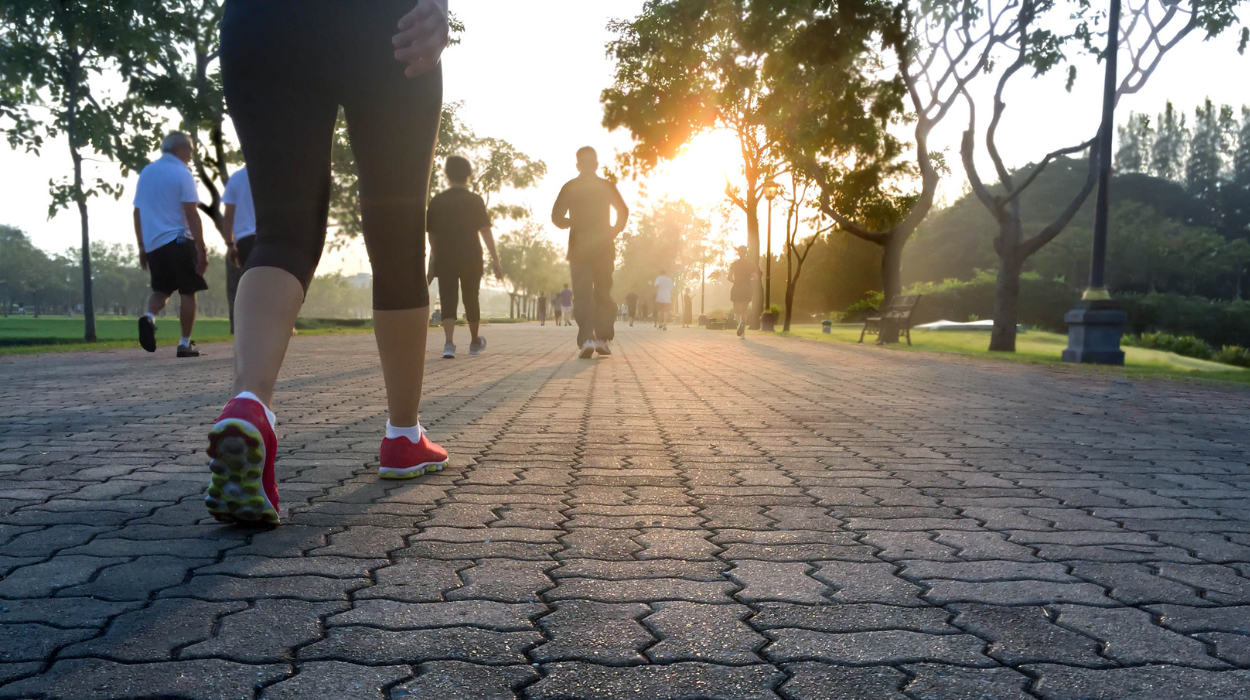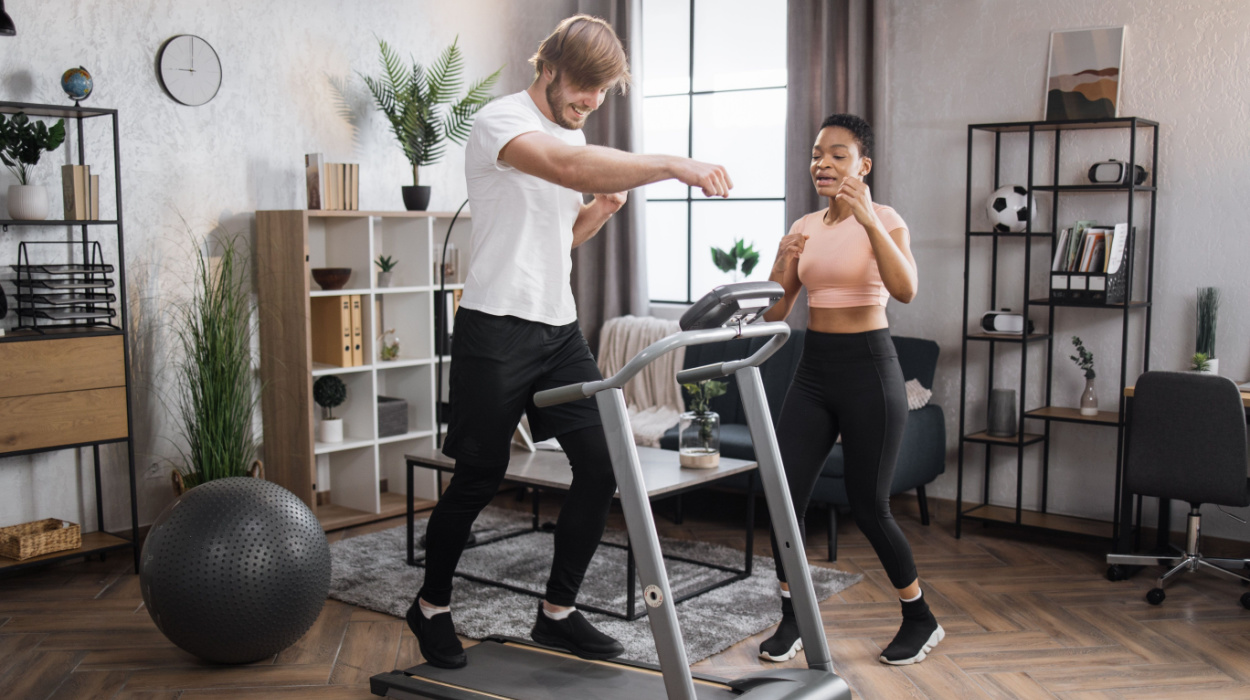Losing weight is both an exciting and challenging journey, one essential for good health and well-being.
If you have a treadmill, your weight loss journey shouldn’t be challenging. Whether a novice or a seasoned fitness enthusiast, the treadmill contains unique features that can help you do more than just walking or running. However, for sustainable weight loss, the treadmill alone cannot help. You’ll need to create a calorie deficit and adopt healthy lifestyle changes for the best results. In this article, we’ll explain how to lose weight on a treadmill. We’ll also unveil a focused plan for losing weight on a treadmill in 2 weeks, discuss the best treadmill exercises, and answer some frequently asked questions.
How To Lose Weight On A Treadmill In 2 Weeks
Are you wondering how to lose weight in one month or even two weeks?
Here are seven easy steps you should consider:
- Set realistic goals.
- Consider your pre-and post-workout diets.
- Treadmill walking.
- Progress to running and sprinting intervals.
- Use the incline feature.
- Stay hydrated when exercising.
- Consider using dietary supplements.
Weight Loss Treadmill Plan For 2 Weeks
Beginning a two-week treadmill weight loss program requires progressively raising the intensity of cardio exercise while incorporating strategic intervals.
You can use strategic intervals to transition from a more challenging activity, such as jogging or brisk walking, to a slower one, such as resting. This approach is intended to make the two-week treadmill program more effective by increasing calorie burn, enhancing cardiovascular fitness, and raising metabolism.
Here are a few things you can do to ensure you meet your fitness goals:
Set Realistic Goals
A plan is required[1] to achieve your weight loss objectives. A fitness plan can assist you in staying motivated, focused, and consistent with your workouts, hence reducing plateauing and overtraining.
Set achievable and well-defined objectives. Examples include the amount of weight you want to lose, the length of time you want to exercise, your workout intensity, and the frequency with which you want to exercise.
Then, keep track of your progress toward your objectives. Adjust your strategy as necessary based on the outcomes you achieve over time. You can adjust the intensity, duration, and frequency of your workouts as needed.
In workout planning, the notion of progressive overload is commonly used. It comprises gradually increasing the[2] load or repetitions performed. For example, you could run on a treadmill set to 3 or 4 mph one week and increase intensity to 5 mph the next.
Consider Your Pre- And Post-Workout Diets
Eating healthy foods and closely monitoring your calorie intake are equally important while trying to lose weight when running on a treadmill. Both before and after exercise, it’s best to eat a balanced, nutritious meal[3] that’s rich in complex carbohydrates, lean proteins, and healthy fats. Meals should be eaten 3 hours before workouts, and recovery foods should be eaten within 30 minutes of exercise to work with your basal metabolic rate.
Arrange your snacks and meals according to when you exercise for the best nutrition. Around an hour before your activity, a tiny carbohydrate snack, like toast or an apple, is a good idea. No later than 30 minutes post-exercise and again 1-2 hours after your workout, have a carbohydrate- and protein-rich snack, such as a protein smoothie with a banana.
Start By Walking

Walking is an excellent choice[4] to get your muscles and cardiovascular system ready for a more strenuous workout on a treadmill. You can burn more calories by increasing your walking distance when you first start using a treadmill.
When done regularly, vigorous walking can have even greater health benefits. To reduce water weight bloat and excess weight period, even just taking a walk may do the trick.
To begin, walk on the treadmill for 15–20 minutes at a moderate pace of 3–4 miles per hour. When you start to feel more at ease and fit, you can walk for longer periods of time, faster and more frequently.
Progress To Running And Sprinting Intervals
Running is an excellent cardiovascular activity[5] for building lean muscle mass. You could start with alternating walking and brief intervals of jogging. To run in the fat-burning zone for longer lengths of time, you must gradually increase the length and intensity of your jogging.
The fat-burning zone is a cardio activity intensity where the body primarily uses fat for energy. It is usually between 60% and 70% of your maximal heart rate.
Sprint for 30-60 seconds at 6-8 mph. After that, reduce your speed to three or four miles per hour and walk for 90 to 120 seconds. After 10 to 15 minutes of this cycle, go for a walk to unwind. This is an example of a HIIT routine, where you do high-intensity exercise for a period of time, take a break, and begin another round of exercise at the same pace or higher.
Use The Incline Feature
Inclines make treadmill workouts more challenging and effective. Because it employs more leg muscles,[6] incline training boosts calorie[7] burning and supports fat loss. Changes in slope activate different muscle groups.
Begin by running or walking for 10-15 minutes at a low incline of 1% to 2%. Increasing your exercise intensity, length, and angle is a wonderful way to track your progress toward your fitness goals.
Stay Hydrated When Exercising

Staying hydrated[8] while exercising is essential for long-term weight loss success. Proper hydration aids detoxification, decreases hunger, and promotes weight loss by removing extra water. Dehydration, however, is a huge pain when exercising and can drastically lower your performance.
Drinking water before, during, and after exercise is important to stay hydrated. Consuming sugary beverages,[9] coffee, or alcohol will impede your weight loss and hydration efforts.
Consider Using Dietary Supplements
The key to dietary supplements and diet pills’ efficacy is a faster calorie metabolism. They are beneficial because they suppress hunger and may prevent the body from absorbing or storing fat.
Fat burners may contain many beneficial vitamins and minerals, and some may even help with weight loss.
Best Workouts On Treadmill To Lose Weight
Try these treadmill workouts that include a range of intensities and approaches to help you lose weight:
Try The 12-3-30 Routine.
YouTuber and TikTok sensation Lauren Giraldo recommends the 12-3-30 method for those looking to kickstart a treadmill workout routine. The treadmill is set to a 12% incline, and for 30 minutes, you walk at a speed of 3 miles per hour. It transforms a slow stroll into a brisk walk with extra benefits.
Despite the 12-3-30 routine’s widespread use, its purported calorie-burning benefits have been largely disproven by research. Even so, it’s still worth it because increasing your heart rate is easy when you run at any speed along an inclination of more than 7%. More than that, it keeps your body from being overworked.
Up The Hill, Down The Hill Strategy
The idea is to increase and decrease the incline while you work out gradually. As the incline grows steeper, you can attempt to keep a running pace, but walking at higher inclination levels is acceptable.
Start your warmup on a gentle slope and gradually increase the speed until you’re running for this exercise. To reach the maximum incline, you must raise it by 1% per minute. At the highest level, get to a flat incline by lowering the angle by 2% every minute after the first minute.
Steady State Cardio
To begin a treadmill workout of low intensity, this may be one of the easiest options. You may alter it to suit your current fitness level to suit people of all fitness levels.
Exercising for as little as 30 minutes at a brisk pace can help you burn 200 to 300 calories, which is a great way to maintain your weight loss goals. Find a running pace that you can sustain for at least twenty to thirty minutes. Before you begin, walk for a few minutes at a pace of two miles per hour to warm up.
Be sure to monitor your heart rate closely. By subtracting your age from 220, you can find your maximal heart rate,[10] which should range from 64% to 76% of the maximum rate during a steady moderate-intensity activity. To calculate for a 30-year-old, 220-30=190x.64 =122 and 190 x .76 = 144, so your heart rate should be 122-144 beats per minute.
Implement A High-Intensity Interval Training Program
A HIIT treadmill workout program is the best option for rapid weight loss. You can rapidly raise your metabolic rate with this tried-and-true strategy.[11] Gradually adjusting your treadmill pace is essential for high-intensity interval training.
Your ability level can also be taken into account when scaling this drill. To get a feel for it, walk as fast as possible for the first two minutes, then ease off. Using the pre-set interval programs that come with most treadmills is another great way to remove any element of uncertainty.
The Traditional 5K
Instead of a time limit, you can choose a target distance. Running five kilometers necessitates a few minutes of warm-up walking, then resetting your distance and gradually raising your speed to a jogging rate you can maintain for the entire distance.
As your fitness level improves, try running faster while tracking how long each lap takes you. You can walk swiftly at first if that is how you feel most comfortable.
Include Strength-Training Exercises
Supporting muscle mass consumes more energy than fat support. Your metabolic rate is linked[12] to the size of your muscles. Your metabolic rate is directly connected to your ability to burn calories and accomplish your ideal weight. A person with larger muscle mass is less prone to overeat since they ate less overall.
The treadmill push can be used as resistance, making it an excellent tool for strength training. To conduct a treadmill push, simply step onto it while it is turned off and push away from the machine with your feet. You’ll be able to keep going if you use the power of your legs to move the belt forward.
How Much Weight Can You Lose In 2 Weeks?
How long does it take to lose weight? According to the CDC, the average person can expect to lose one to two pounds weekly. You may lose 4 to 8 pounds per month by achieving a calorie deficit of 500-1,000 calories per day through calorie restriction and calorie burn from exercise.
Setting reasonable goals makes it much easier to lose this much weight. When arranging your fitness schedule, be as specific as possible about the time and frequency of your workouts.
Whether you want to lose weight on a treadmill for two weeks, a month, or a year, burning calories moderately is the way to go. This way, it’s more likely that you’ll never get it back. Reaching your goal weight is pointless if you can’t keep it off.
The number of calories expended during a treadmill workout depends on several factors. The key factors include age, weight, height, and the frequency, intensity, and duration of your calorie-burn activities. Even the quality of your sleep[13] has an impact on your calorie-burning potential.
Conclusion
Using a treadmill for weight loss requires an appropriate strategy. Begin with walking, progress to running, try inclines, and keep organized. Hydrate yourself and plan what you’ll eat before and after your workout. These measures can boost calorie and fat burn, resulting in more effective weight loss.
Combine your treadmill workout with a healthy diet and other physical activities to get the most out of your treadmill workout. Weight loss is a complicated and gradual process, so be patient and persevere.
Frequently Asked Questions
Treadmill HIIT workouts, alternating sprints with rest periods, is an efficient technique to burn calories and reduce weight.
Yes, a daily 20-minute treadmill workout that includes intervals and an intense workout can help you lose overall body weight over time.
For the best benefits, walk quickly on a treadmill at around 4 mph, increasing the pace as your fitness level improves.
Running on a treadmill helps burn body fat, even belly fat. Combine with a well-balanced, hypocaloric diet for the best results in reducing abdominal fat.
 Evidence Based
Evidence Based
